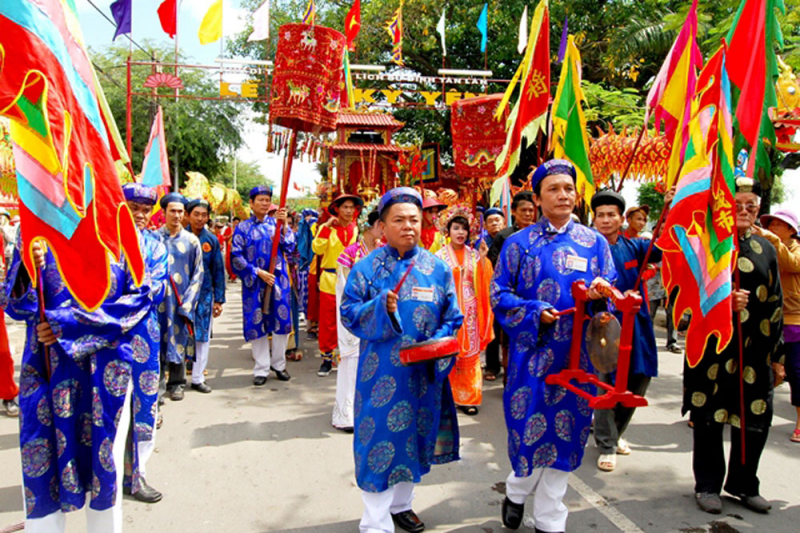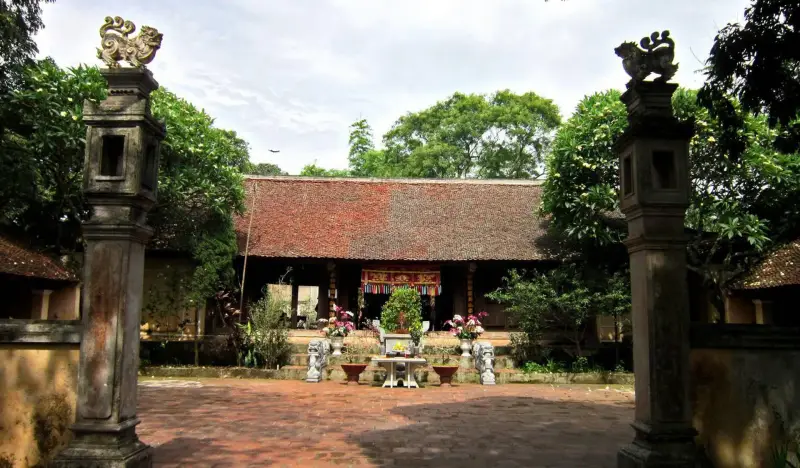Duong Lam Ancient Village – “Forgotten Old Town” of the capital
44 km from Hanoi, Duong Lam ancient village is the perfect choice if you are looking for a peaceful countryside to rest after the chaos of life. This place also preserves many old architectural houses with brick roads, laterite walls, and cultural features of the countryside in the North. Let’s “pocket” right away the latest Duong Lam ancient village travel experience below!
Where is Duong Lam ancient village?
Duong Lam ancient village is located in Son Tay district, Hanoi, only 44 km from the city center. Duong Lam is the hometown of Ngo Quyen and Phung Hung, so it is called “the land of two kings”. To this day, Duong Lam village still retains the basic features of a village in the North with village gates, banyan trees, a water wharf, a communal yard, … with 956 traditional houses. In 2006, Duong Lam became the first ancient village in our country to be awarded the National Historical and Cultural Relic by the State.
The right time to visit Duong Lam ancient village
You can go to Duong Lam ancient village at any time of the year. However, the festival season and the ripe rice season are the most suitable times for a trip.
- Festive season
Duong Lam village festival season takes place in the first lunar month every year. The traditional festival of Mong Phu village takes place from the 4th to the 10th, which is considered the most sacred festival of the year. The ceremony of Thanh Hoang village is held at the oldest village communal house with palanquin processions, pig offerings, chicken offerings, etc. After that, the villagers will participate in folk games such as human chess, chess, and fighting. chickens, blindfolded to catch ducks, etc., creating a joyful and bustling festive atmosphere.
6 days later, the festival of Dong Sang village was held, praying for national peace and good harvest with many attractive activities such as lion dance, water procession, and sacrifices. The water procession starts from the village communal house to the banks of the Red River with dragons, unicorns, horses, flags, etc., lasting for nearly a day. Coming to Duong Lam during this time, you will enjoy the bustling festival atmosphere and enjoy the special dishes that are only available at the festival.

- Ripe rice season
Every year in May and June – when the rice fields are fully ripe, Duong Lam on the day of the season is also the time when tourists flock here the most. The roads in Duong Lam are covered with rice and dry straw, creating a peaceful and peaceful village scene that is rarely found anywhere else.

Duong Lam ancient village tour
Mong Phu village gate
This is the only ancient gate remaining to this day in Duong Lam. The village gate was built in the Later Le Dynasty, and has a different architecture compared to the traditional village gate, like a house with two sloping roofs, with pillars supporting the roof and top of the roof in the style of “upper family Xiamen” (above is a house, below is the gate). Mong Phu Gate together with banyan tree, water wharf, and lotus pond create a typical scene of the old village of the North.

Mong Phu village communal house
Mong Phu communal house was built nearly 380 years ago on the central land of the village, about 1800m2. The design of the communal house is bold with Vietnamese – Muong architecture, simulating the architecture of a house on stilts with wooden floors separated from the ground. The communal house consists of two palaces and a harem. Dai Bai house is built with 48 wooden columns, above each column, there are many carved dragon and phoenix patterns.
Inside the communal house, many parallel sentences are hanging. The most prominent is the “old dragon trainer” painting, which is an old dragon teaching children, and the “brave and thinking” painting by King Thanh Thai. It also preserves many unique architectural and cultural values, attracting tourists.

Church of Detective Giang Van Minh
Built during the reign of King Tu Duc to worship and remember the merits of Detective Hoa Giang Van Minh. The church faces the South, and has architecture in the shape of the word “second”. Today, the church has become an attractive tourist attraction for tourists interested in learning about history and culture, as well as a place to educate the patriotic traditions for the younger generation.

Old houses
Duong Lam ancient village has 956 ancient houses, many of which were built in the years 1649, 1703, 1850, etc. These old houses are all made from traditional materials: laterite, oval wood, etc. bamboo, terracotta bricks, tiles, etc. with 5 or 7 compartments of architecture.

Duong Lam Ancient Well
In the past, the village well was the place where people got water for daily life. The ancient wells here are located in a high, cool place, near the communal house, pagoda, or the center of the hamlet.

Temple of Phung Hung
Phung Hung was the leader in the uprising against the harsh domination of the Tang Dynasty during the Northern colonial period in Vietnam. After the successful uprising, Phung Hung built an autonomous government and ruled for 7 years.
To commemorate this special king, Phung Hung temple was established in many places. However, the most sacred and large-scale must be mentioned is the temple of Phung Hung in Duong Lam Ancient Village. This is because Duong Lam is the place where this national hero was born and raised.

Mausoleum and Temple of Ngo Quyen
About 500m from Phung Hung temple is Ngo Quyen mausoleum. The complex of Ngo Quyen temple and mausoleum was built on Cam Hill, in front of which is a large rice field and the Lom valley flowing into the Tich River. The temple consists of a place of worship, a great cult, a harem, and a stele house. At the bottom, about 100m from the temple, is King Ngo’s mausoleum built in the shape of 4 roofs on a high pedestal, surrounded by walls.

Hopefully, the experiences of traveling to Duong Lam ancient village that we detailed above have helped you build the most convenient, complete and fun schedule to visit and explore Duong Lam.

